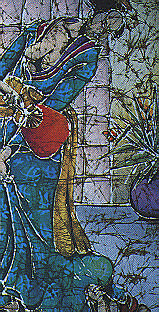Since the days of Walter Raleigh, the name La Brea has been synonymous with Trinidad’s Pitch Lake (La Brea means pitch in Spanish). Its churning asphalt saved Raleigh’s leaky fleet, and its endless supply gave smooth surfaces to the roads of the world until a synthetic equivalent made it redundant. Because of the Pitch Lake, the land around La Brea is unstable, and the industrial investment enjoyed elsewhere in South Trinidad has passed it by.
It seems a bizarre destination for artist Jane Downer. But suddenly the reason is evident as a cluster of well-maintained octagonal cottages comes into view, surrounded by tall cannonball and breadfruit trees. This is literally cottage industry: cottages have been built in rural areas such as Piarco, Fyzabad and La Brea to develop traditional crafts like leatherwork, wood carving, ceramics and batik. All goods produced at the craft centres are sold through the Small Business Development Company in Trinidad or in other Caribbean islands.
La Brea concentrates on batik, and Jane Downer, who has an international reputation for her own batik, has been working as a consultant there. The group consists of about 15, men and women, from a wide age range. Some have no previous experience in any form of art. They are paid a stipend of TT$40 a day (about US$6), but the incentive is to learn a trade. Most of them admit that without this they would be at home without any means of employment. At the end of the year’s training, a core group remains to help an incoming group, while others get help from the SBDC to set up production units in their own homes.
They have mastered the batik technique and now produce brightly-coloured beach wraps and yardage for dress designers. Jane has been focusing on developing their drawing skills. Today a potted banana plant is placed behind a grid. She explains that the importance is to see each individual square of the grid as a small picture which will eventually form the complete big picture, to draw the form and line, positive and negative space. Some look bemused at the prospect, but Jane’s approach to her teaching is holistic, as is her own approach to life. She tries to encourage each participant to see with his own eye, to understand that everyone has a valid perspective, and to realise individual creative potential.
This is, at times, a difficult message to get across to people who have never before been exposed to someone like Jane. But the obvious love she has for what she does and for those she is teaching is inspirational, and all agree they have benefited tremendously from her input.
Now in her forties, Jane was born in England but has spent most of her life in Trinidad; her first impressions of its lush beauty made an indelible impression on her. After graduating in Printed Textile Design from Liverpool College of Art in the early 1970s, she returned to Trinidad for Carnival, then decided to travel on a ferry boat up the Caribbean island chain. On a beach in St Vincent she discovered an English couple, Clive and Eileen Stevenson, who had set up a batik studio on the beach, selling fabrics to the passengers of passing schooners.
Jane was entranced, and stayed three months as an apprentice. “The setting was idyllic. We built a fire of driftwood to boil the wax, and worked long hours, from seven to four, but whenever it got too hot we just swam in the sea.” The Stevensons taught a unique craft, a combination of traditional Javanese batik technique and hand-painting. Jane is convinced they were the first westerners to produce batik by this method, which she in turn is passing on to her students.
On her return to Trinidad, Jane decided to start designing and painting her own individual pieces. Her first exhibition was in 1974 at the National Museum in Port of Spain, but she has since had many others in Trinidad as well as London, Edinburgh and Switzerland. Her work has received high critical praise, and her paintings are collectors’ items. Her main inspiration is the flora and fauna of the islands, whose voluptuous natural images she captures in spectacular form and colour. A dazzling blue hummingbird dipping its beak into a red hibiscus flower, the reds and yellows of heliconia, the many species of orchid, the luxuriant greens of the foliage — all come to life in her work.
She has an obvious love for people and has done a series of rural subjects like Woman Cooking Roti. She is constantly fascinated by the “connectedness” between, say, a mother and child or a ripe fruit on a woman’s scale. She has done many commissioned pieces, including a creation scene for a church in Notting Hill and a series on Carnival for the Notting Hill Carnival Committee. She has always worked on her own, never wanting to set up a business. “I am a perfectionist and quite bossy, and if I had people helping I don’t think I would do the work,” she admits. “Working on my own has been great, a wonderful form of therapy. But I wanted to do something more community-minded, so the teaching is great.”
Jane has been involved with the spirituality of the East for over 25 years through practising and teaching yoga and meditation. She has learned the Japanese massage art of Shiatsu, and at this stage in her life finds much fulfilment with these elements in her life. “I would like to find a way of putting it all together, but I haven’t found it yet,” she says. “I think it is very important to pass on knowledge. I also hope by doing that I will in some way be able to give it up. I hate to think I will be still painting flowers when I am 90.”





















